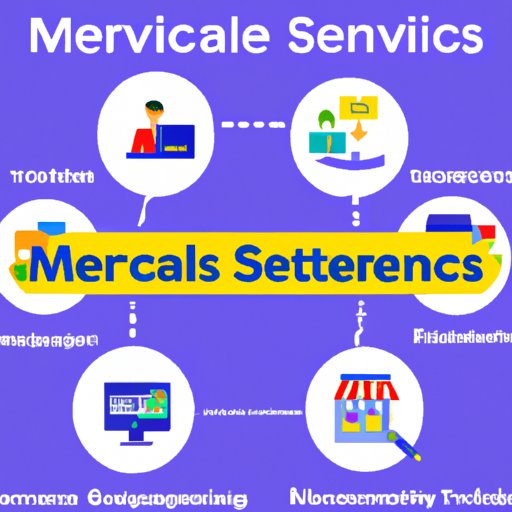Introduction
A merchant services business provides credit card processing and related services to businesses, allowing them to accept payments from customers. Starting a merchant services business requires research and planning. In this article, we will provide a step-by-step guide on how to start a merchant services business.
Research the Market and Competition
The first step in starting a merchant services business is to understand the marketplace and analyze competition. You should research the current market for merchant services, identify customer needs, and analyze potential competitors.
Understand the Marketplace
You should research the current market for merchant services and identify customer needs. This includes understanding the types of products and services offered by competitors, the customer base, and the associated costs. You should also consider the advantages and disadvantages of each product or service.
Analyze Competition
It is important to understand who your competitors are and what they offer. Analyzing your competition can help you determine which services to offer and how to differentiate yourself from other providers. You should also look at competitor pricing, customer service, and marketing strategies.
Create a Business Plan
Creating a business plan is essential for any new business. Your business plan should include your goals, financial considerations, and a risk assessment. It should also outline how you plan to achieve success.
Goals
Your business plan should include your long-term goals as well as short-term objectives. Your goals should be specific, measurable, achievable, realistic, and timely (SMART). Outline the steps you need to take to reach your goals.
Financial Considerations
Your business plan should include a financial analysis of your expected expenses, revenue, and profits. You should also consider the cost of equipment, software, and personnel. Additionally, you should factor in the cost of marketing and advertising.
Risk Assessment
Your business plan should include an assessment of potential risks, such as changes in the economy, technological advances, or legal issues. This assessment should include strategies for mitigating these risks.
Obtain Licensing and Insurance
Before starting your merchant services business, you should obtain the necessary licenses and insurance. Licenses vary depending on the type of business you are operating and where you are located. You should also obtain business liability insurance to protect your business from potential losses.
Licenses
You may need to obtain several licenses, such as a business license, a sales tax license, and a money transmitter license. You should research the requirements in your area and apply for the necessary licenses.
Insurance
You should obtain business liability insurance to protect your business from potential losses. This insurance should cover losses due to theft, fraud, or other criminal activities. Additionally, you should consider purchasing cyber liability insurance to help protect your business from cyber attacks.
Choose a Payment Processor
Choosing a payment processor is an important step in setting up your merchant services business. You should consider the types of payments you want to accept, the fees and costs associated with the processor, and the security features offered.
Types of Payment Processors
There are several types of payment processors available. These include traditional payment processors, such as banks, and alternative payment processors, such as PayPal and Stripe. Each type of processor has different features and fees.
Fees and Costs
Payment processors typically charge a fee for each transaction. Additionally, there may be additional fees for setup, monthly fees, and other fees. You should compare fees and costs before selecting a processor.
Develop an Online Presence
Having an online presence is essential for any business. You should develop a website that clearly outlines your services and allows customers to make payments. Additionally, you should use social media to promote your services and engage with customers.
Website Design
Your website should be user-friendly and visually appealing. It should include information about your services and allow customers to easily make payments. Additionally, your website should be optimized for search engine visibility.
Social Media
Social media is a great way to connect with customers and promote your services. You should create accounts on several platforms and post regular updates. Additionally, you should respond to customer inquiries promptly and professionally.
Establish Partnerships
Partnerships can help you reach new customers and expand your business. Networking with other professionals in the industry can help you find potential partners. Additionally, you can establish affiliate programs to promote your services.
Networking
Networking with other professionals in the industry can help you find potential partners. You should attend industry events, join professional organizations, and build relationships with key players in the industry.
Affiliates
Establishing an affiliate program can help you reach new customers and increase your revenue. Affiliates are paid a commission for promoting your services. You should research potential affiliates and create an attractive compensation package.
Market Your Services
Marketing is essential for any business. You should create a comprehensive marketing strategy that includes both traditional and digital methods. Additionally, you should establish promotional activities to generate interest and attract new customers.
Advertising Strategies
Your advertising strategy should include both traditional and digital methods. Traditional methods include print and radio ads, while digital methods include pay-per-click campaigns and email marketing. You should also consider using guerrilla marketing tactics to reach potential customers.
Promotional Activities
Promotional activities can help you generate interest and attract customers. You should consider offering discounts, hosting contests, or providing free consultations. Additionally, you should consider partnering with local businesses to promote your services.
Conclusion
Starting a merchant services business requires research and planning. The steps outlined in this article include researching the market and competition, creating a business plan, obtaining licensing and insurance, choosing a payment processor, developing an online presence, establishing partnerships, and marketing your services. With the right planning and effort, you can successfully launch your own merchant services business.
(Note: Is this article not meeting your expectations? Do you have knowledge or insights to share? Unlock new opportunities and expand your reach by joining our authors team. Click Registration to join us and share your expertise with our readers.)
